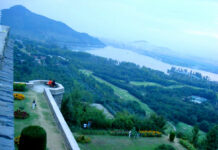In her latest Srinagar visit, noted environmental activist Sunita Narian was offended by a set of questions that she faced after delivering an impressive lecture. Her audience, mostly scribes wanted to know her response on issue like the impact of militarization on fragile ecology, the fate of Siachen glacier, managing increasing incidence of man-animal conflict especially when the wildlife has its habitat critically interrupted by the LoC fence and how a series of hydropower dams could be managed at a place falling under seismic zone-V. She responded to a few but generally felt offended for the “political” nature of the questions.
It would require a highest degree of impartiality and statesmanship to even touch such critical issues, Kashmir is confronted with. But that does not, anyway undermine the impressive piece of analysis that Ms Narian shared over the weather situation and its linkage with the climate change. Her observations must form a priority piece of advice for policy makers and the urban planners.
Reiterating that the perceptible climate change is going to be making the Himalayan region all the more vulnerable, Ms Narain said certain changes are already visible and scientifically established. Variable monsoon is getting all the more variable and Western disturbances are severely impacted by fast heating up Mediterranean and the Tibetan Plateau. This essentially is leading to a situation that the Western Disturbances are bringing in more water, once colliding with monsoon from Bay of Bengal, are creating situations like that of September 2014. Fast heating up Tibetan Plateau is triggering instability in weather and wind patterns. Variable Arctic Front has already unleashed heatstroke events across the region.
Warming atmosphere is holding more water and offering more rain in extreme spells thus threatening a change in the impact that monsoons have on economy of the Indian subcontinent. She feels India’s average yearly rainfall hours may reduce from the existing 100 even though there might be increase in its quantum. This eventually would require change in life patterns and improvement in water harvesting systems.
Studies have already indicated that gradual increase in the sea temperatures could weaken monsoons, which are outcome of the net difference in temperatures on land and sea. That can wreck havoc.
Climatic change is obviously linked to the carbon footprints that are quite huge in Western and developed nations than in developing and the poor members of UN. While there is requirement for serious campaign for implementing Kyoto Protocol of 1992 quite fast, the developing states also need to evolve a new development strategy that would avoid least carbon emissions, unlike the West.
Srinagar, for instance, could prove one of the highly polluted cities in the East because the air quality is literally suffocating. There has not been any serious effort by the government to improve the situation by at least introducing the CNG, the city would require a rapid mass transport set-up. Since the initiative would require lot of resources, the government may not dislike throwing in funds for a long-gestation project when it needs less money for harvesting low-hanging fruit. There is no possibility of a private investment or multi-lateral funding. That is how everything in Kashmir eventually becomes politics.









